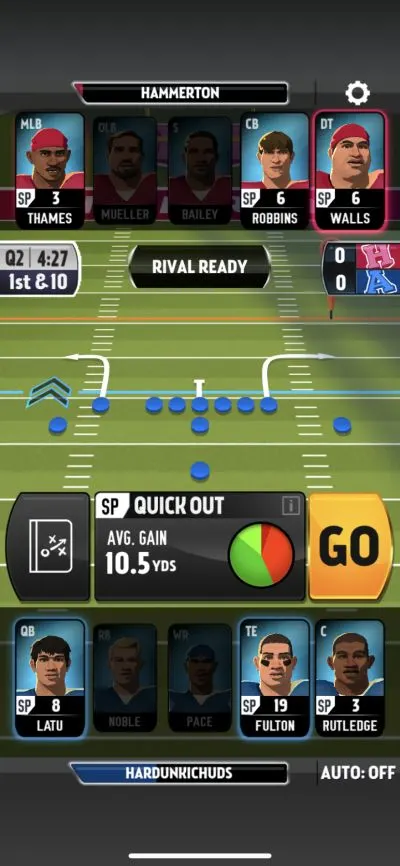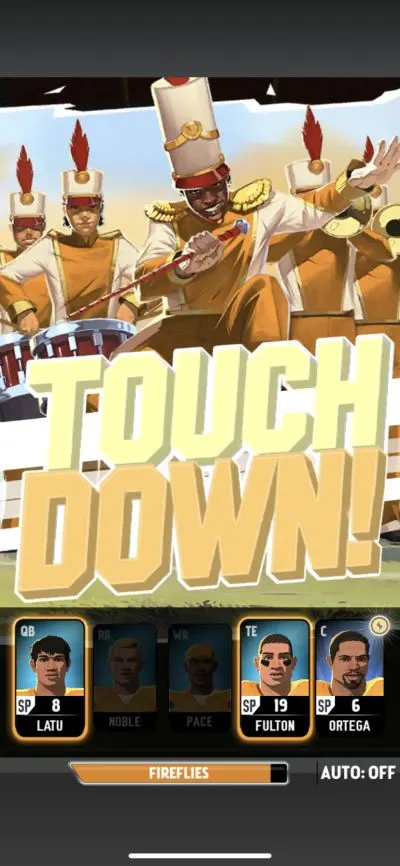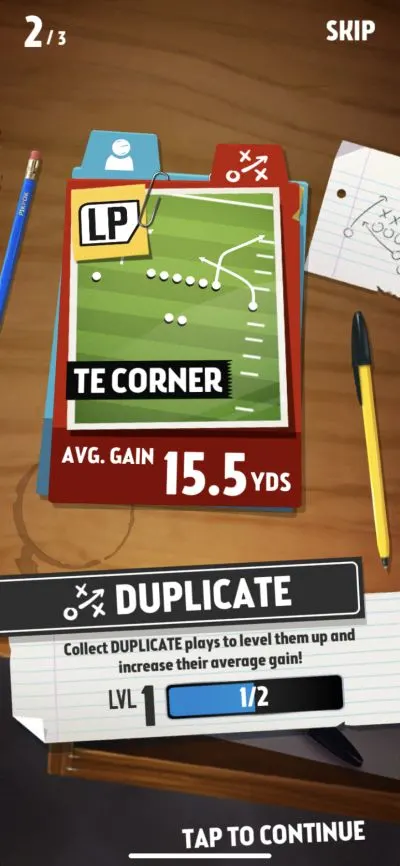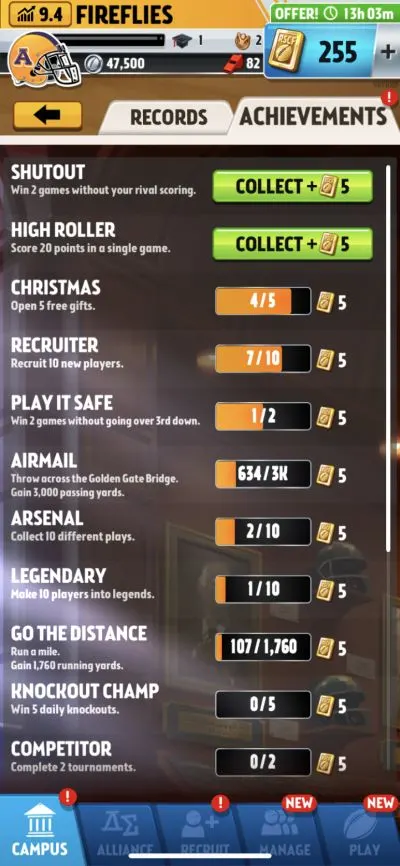We’ve covered more than our share of mobile games based on professional sports, so why not head to the campus and play some college sports for a change? PikPok is known for popular mobile games such as Into the Dead 2, Kung Fu Clicker, and Rival Stars Horse Racing, and much like the latter game, Rival Stars College Football is something that’s arguably for the more casual gamers out there while not being all-out casual.
This game allows you to take charge of a college football program and build your team from the ground up, starting out with the usual team of scrubs and recruiting new players, adding new plays to your playbook, and competing in various game modes that include PvE matchups, as well as those where you can get social, team up with other human players, and compete against rival alliances. Are you ready to take your team to the top and induct more players into the Hall of Legends?
Unlike most of the other sports games we’ve covered as of late, this mobile title exclusively features fictional players and teams, and the mechanics are fairly stripped down compared to, say, Madden Mobile 20. So let’s get down to business and get you started with this Rival Stars College Football strategy guide, where we shall be focusing on beginners’ tips for anyone who’s downloaded this game for the first time and wants to win more games and improve that roster without spending a single cent of their real-world money.
1. The Basics Of Rival Stars College Football
Rival Stars College Football is in essence a strategic, some may say role-playing game more than it is a classic American football simulation. While most games of this kind would require you to control players on offense and defense (mostly the former), the matchups in this game would only require you to call plays, and nothing more. There’s no need either to consider substitutions or debate on whether to insert a third-down back or have the fullback rush the ball or catch a pass instead of doing his usual blocking duties, or switch from a 4-3 defensive scheme to a 3-4. That’s because there are only five positions each for offense and defense, plus your usual special-teams (who aren’t represented by anyone in specific) – it seems that the game’s makers wanted to keep things as simple as possible without reaching purely casual territory.

On offense, you’ve got one quarterback, running back, wide receiver (instead of the usual two), and tight end each, as well as one center instead of a full offensive line that also includes two tackles and two guards. And on defense, you’ve got one outside linebacker and middle linebacker each, one cornerback, one safety, and one defensive tackle (no defensive ends here, unfortunately). Each player has four individual stats or attributes – IR (Inside running), OR (outside running), SP (short pass), and LP (long pass) – we believe this pertains to how well players perform during these plays. In other words, don’t expect the game to measure the usual attributes like athleticism, arm strength and accuracy (for quarterbacks), or speed (mainly for WRs and defensive backs).
Each game consists of four five-minute quarters (not in real-time – the time it takes for plays to be completed is simulated), which means that the scores could be rather low compared to actual college football games. You can also earn up to three footballs (the game’s equivalent of stars) in a game, with each football (or qualification point) corresponding to specific milestones, e.g. simply winning the game, winning by a certain margin, etc. You can also earn other freebies for a win, including Training Whistles (as designated by the whistle), silver, which is the game’s currency, and gold (the premium currency), and double most of those rewards by watching a 30-second ad video. One important caveat – we said “most” of those rewards, and that means only your silver and TP will be doubled, but not your gold!
There are other aspects of the game that would need to be discussed in this beginner’s guide, but before we get there, let’s talk about the very meat of this game – the play-calling.
2. The Fundamentals Of Play Calling
As we’ve established, you will be doing a lot of play calling in Rival Stars College Football, and while the mechanics here are far more casual than what you’d get in any Madden NFL Mobile game, the offensive and defensive plays you call matter a lot. These could mean the difference between victory and defeat, between a perfect three footballs and a solid two or a mediocre one. Different situations will warrant different plays, but since we’re still touching on the basics, there are some simple things to keep in mind when calling plays in this game.
First off is that each offensive play will come with an accompanying pie chart that tells you the initial chances of success without the variable of your opponent’s defensive strategy figured in – usually, the better plays to execute are those where the pie chart is at least 50 percent green. A pie chart that’s mostly red, quite obviously, suggests that the play doesn’t have a good chance of being executed successfully. Once your opponent (or you, if the opponent is on offense) chooses their defense, that green area could increase or decrease in size, depending on how effective the defensive strategy is!

Each offensive play is categorized as into inside running, outside running, short passing, or long passing, and also comes with a yardage figure on the corresponding card – this is the average yardage you can expect if you execute the play successfully. Typically, low-risk plays result in low yardage gains but have a very good chance of success, while high-risk plays result in bigger gains but only give you a low chance of success. Also, after an offensive play is chosen and called, a needle circles around the pie chart and stops after a couple of seconds – if it stops at green, you gain some yards, and if it stops at red, you lose yards or throw an incomplete pass.
Although the game does say you’ll have to “guess” which plays the opposition is calling, that pretty much applies mostly to first-and-10 plays. This would mean your first down for the offensive or defensive series, or a fresh first down later on in your offensive drive. Otherwise, it’s quite easy to figure out what to do in most other situations. If you’re near the opponent’s end zone, e.g. a first/second/third or even fourth-and-goal situation, you want to focus on your running game, but mix things up with some short passing plays because your opponents will usually stick to defending the run in goal-line situations.
Third-and-long (e.g. third down with more than 6 yards to go for a first down), on the other hand, would almost always require you to call a passing play. Also, any time you have four yards or less remaining before a first down, running is the best way to go; otherwise, you can call a short or long passing play to gain some valuable yardage. Regardless, you’ll have to make sure you have as good as possible a chance of executing the play based on the pie chart!
On defense, it helps to apply these same principles when choosing a play to call, even if you’re limited to choosing a balanced defense, run defense, pass defense, or blitz, with no specific plays. On the first down, you would normally want to go for a balanced defensive approach against the opponent while they’re on offense. Defend against the pass if your opponent is at third-and-long, defend against the run during goal-line situations or if they have less than four yards to go before getting another first down. But in both cases, it’s also important to mix things up and not get too predictable, lest you risk getting intercepted (or surrendering a lot of yardage) losing an important game against a particularly tough opponent – for example, the opponent may choose to run on a third-and-11 situation while you’re defending against the pass. This just MIGHT end up in a first down, even if the logical play in such a situation would be to throw a long pass!
The game will also auto-suggest plays for you before you’re given the option to choose your own plays, though these are usually the most simplistic, obvious suggestions. You can go for the AI-suggested plays if you’re trying to mix things up, but otherwise, it’s best if you do the play-calling yourself to better fine-tune your strategy, regardless whether you’re up against a weak or a strong opponent.
3. Don’t Let Your Players Get Too Demoralized
On the game screen, you will notice a bar containing each team’s name, with the bar filling up or running out depending on the outcome of certain plays. This represents each team’s morale, and it goes without saying that good things – a touchdown score, a key defensive stop, a clutch reception or running play that turns third-and-long into a first down – could significantly cause the bar to fill up quickly.
Conversely, expect the bar to run out once the ball gets intercepted, if you’re unable to prevent a play on defense, or if you’re unable to squeak out the first down at third-and-1, or unable to score a touchdown while mere yards away from the opponent’s end zone. In particular, your performance in third-down situations would have a lot of bearing on morale – after all, failing to convert would essentially end your drive on offense, while getting a first down will extend it and bring you closer to that elusive touchdown. (Or, if you have to settle, a field goal.) Good morale, naturally, improves the chances of play execution, while bad morale harms it.
Unfortunately, the game’s stripped-down mechanics do not allow you the option to call a timeout to help your team regroup and forget about their frustration, so your only recourse in the event your team is suffering from bad morale is to call smarter plays. Of course, it will be harder to make those plays work with morale lower than it should be, and that’s sadly something you’ll need to deal with when coaching games in Rival Stars College Football.
4. Redeem Those Free Gifts

If you want more gold, silver, and Training Whistles, you’ll need to go back to the game every three hours or so to redeem your free gifts – or as the game suggests, contributions from your university’s backers. At the end of the day, it won’t be much – for example, you can only expect about 10 gold and 10 Whistles– even if the game allows you to watch a video to redeem additional gifts. But if you consider that you can take advantage of these freebies about five or six times a day at most (depending on how long you sleep), the gifts can add up and give you more resources to improve your players and recruit better ones!
5. Recruit New Players And Unlock New Plays Through The ‘Recruit’ Menu
Once again, there are only ten positions in the game – special teams players, as we mentioned above, do not count, so you only have your five offensive players and five defensive. There also aren’t too many players to choose from – of course, they’re all fictional – but you will eventually recruit enough of them to substantially improve your roster and give you a better chance of winning more games in Rival Stars College Football’s campaign mode, as well as in the other game modes.
Each player is rated from 1 to 5 stars, with the rarity and skill increasing as you move up one star, and at first, you’ll likely be happy with your first two-star players recruited via the Local Search. Local Searches in the Recruit menu are free every eight hours and come with two players, rated from 1 to 4 stars – you can choose to speed this up by spending gold, but you would want to avoid this in almost every situation. For 250 gold, you can perform a Statewide Search and get two players rated from 2 to 5 stars, and for 1,000, you can do a Nationwide Search with 10 players, again from the same 2-5-star range. We strongly suggest saving your gold for the Nationwide Search – the game itself says it offers the best value for your currency.
In addition to new players, each recruiting search unlocks new plays that you can add to your playbook via the Manage menu and the Playbook sub-menu. You are only allowed a maximum of eight active plays in total, so choose wisely and feel free to mix them up from time to time! For Local and Statewide searches, you get one play each, but for Nationwide, you get a whopping five, so that’s another argument for waiting till your first thousand in terms of gold before splurging on a Nationwide Search.
6. Duplicate Players / Plays And Player Training
At some point while playing Rival Stars College Football, you will turn up with your first set of duplicate players or plays while performing your searches. But that is, in no way, a bad thing – in fact, getting a duplicate of a player on your roster or a play on your playbook is a good thing. For duplicate plays, each dupe brings you closer to leveling them up and increasing their average yardage gains – moving from level 1 to 2, for instance, would require two dupes of that given play. Duplicate players, on the other hand, will come in handy when upgrading a player’s star rating, which we’ll talk about in a couple paragraphs.

It’s as simple as that, so don’t be disappointed if your search yields dupes – sometimes, it could be the best thing that could happen to your team at that given moment. When it comes to training and improving your players, you can also level them up with your Training Whistles – of course, you should focus your upgrades on your better players and not use those Training Whistles arbitrarily – each upgrade starts at 10 Whistles, and the cost increases progressively as a player levels up.
Players increase star rating every 10 levels and unlocks a new skill (more on this in a later guide), and but before you reach that point, you’ll need to have enough duplicates – yes, that’s where they come in – and enough silver on you. Reaching 5 stars makes a player a “legend,” which automatically provides a permanent 1 percent ratings boost for all stats for anyone who plays their position! (You may already be aware of this, as the game will automatically make one of your players a Legend as a complimentary freebie to help ease you into the scheme of things.)
7. Save Auto-Play For Those Super-Easy Matchups
It doesn’t matter if you’re playing the game’s campaign mode (Road to Glory) or trying to grind for gold in the tournaments or playing any other game mode. Auto Play is only suggested for those super-easy games where you’ve got a comfortable advantage over your opponent in terms of average rating. That means if you’ve got a particularly powerful team that has about double the average rating of your opponent, you’re free to toggle the Auto switch on the bottom right of your screen and let the AI do all the coaching for you – you’ll still get the same Whistles, Silver, and Gold rewards and would still have a chance to double the first two rewards by watching a video.
However, if you’re only a few points ahead of your opponent in terms of average rating, you’re better off calling the plays yourself – AI coaching, once again, does not allow for the sophisticated tweaks only a human player can make, and mostly relies on the most obvious (but not always the best) option available at any given time.
8. Earn More Gold By Completing Achievements

Last, but not least for this guide, you can access the Hall of Records in the main (Campus) menu and tap on the Achievements tab in order to see how close you are to reaching certain milestones in the game. For example, these may include recruiting a certain number of players, converting a given number of players into Legends, collecting a specific number of plays, reaching point milestones in a game, and many more. Depending on how easy or how hard it is to pull off these feats, you can earn anywhere from 5 to 25 gold, so make sure to check back on this screen on a regular basis to see how close you are and to see what you need to do to complete a given Achievement!
And this ends our detailed guide for Rival Stars College Football. If you happen to know more tips or strategies for the game, feel free to let us know by leaving a message in the comment area!

Carlton Hall
Monday 7th of September 2020
What does “top tier” mean? How do I achieve this dream? It’s not playing the top team listed in the tourney ratings?